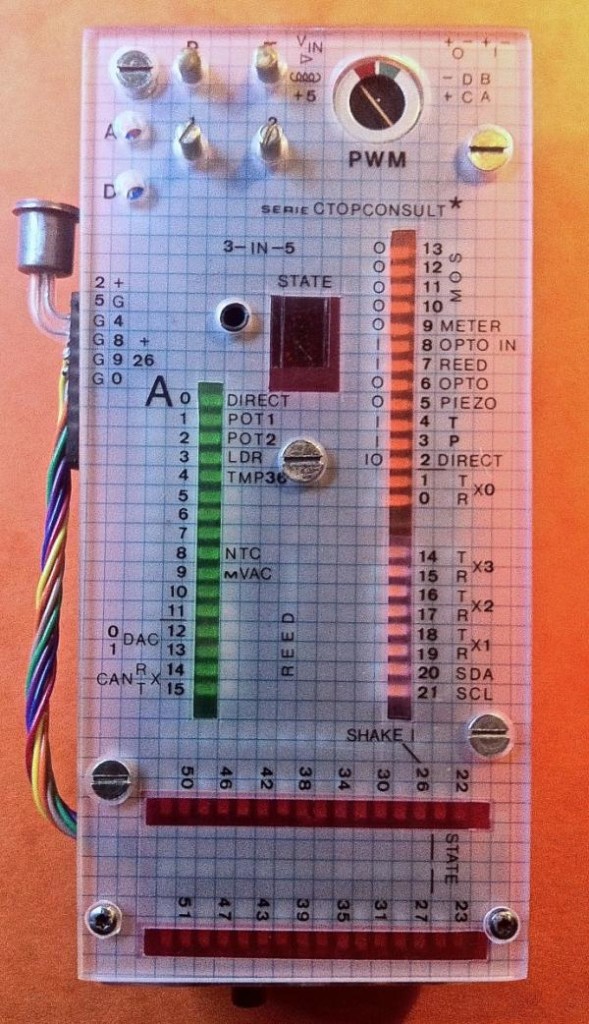Summary of Arduino Monitor/Tester
This Arduino Monitor/Tester is a comprehensive testing board compatible with various Arduino models, featuring LEDs for each input/output to visually indicate pin voltage or PWM duty cycle. It includes built-in components such as pushbuttons, switches, potentiometers, sensors, opto-isolated I/O, and a small voltmeter for monitoring signals. The design supports flexible power options and passive input modes, with 70 high-efficiency LEDs grouped for analog and digital signals. Detachable modules house sensors and special connectors for versatile testing scenarios, making it ideal for developing and troubleshooting Arduino projects.
Parts used in the Arduino Monitor/Tester:
- One LED per input/output (70 total, high-efficiency white SMD with colored film)
- Pushbutton (digital input)
- Toggle switch (digital input)
- Two potentiometers (analog inputs)
- 4-digit HEX display (digital outputs)
- Small moving coil voltmeter (PWM output)
- Piezo loudspeaker (PWM output)
- Open-drain MOSFETs with builtin flyback diodes (4 digital outputs)
- Opto-isolated digital input
- Opto-isolated digital output
- Miniature LEMO coax connectors (for analog input and digital I/O/PWM)
- Reed relay (coil-less, digital input)
- Mercury shake alarm sensor (digital input)
- TMP36 temperature sensor (analog input)
- Electret microphone with x100 gain (analog input)
- NTC resistor (analog input, linearized)
- Light-dependent resistor (analog input)
- IC sockets and Arduino pins (gold plated)
I finally finished my Arduino Monitor/Tester!
This is how it turned out to be:
- One LED for every single input or output
- Can be used with Uno, Leonardo, Mega, Due, Mini, etc.
- Also fits with my universal I/O board
- Power taken from Arduino 5V and 3.3V outputs, and the Vin
- Load on any pin is 10 kohm or more
- LED intensity proportionally reflects the pin voltage or duty cycle
- Builtin inputs and outputs for testing new ideas:
- One pushbutton (P) to digital input
- One toggle switch (T) to digital input
- Two potentiometers (1, 2) to two analog inputs
- 4 digital outputs to HEX-display (e.g. for program STATE output)
- Very small moving coil voltmeter on PWM output
- Piezo loudspeaker on PWM output
- 4 digital outputs to open-drain MOSFET (builtin flyback diodes)
- One opto-isolated digital input
- One opto-isolated digital output (not for 230 VAC)
- One direct analog input via miniature LEMO coax connector
- One direct digital I/O/PWM via miniature LEMO coax connector
- One reed-relay (no coil) to digital input
- One mercury shake alarm to digital input
- One TMP36 temperature sensor to analog input
- One electret microphone to analog input (x 100 gain)
- One NTC resistor to analog input (linearized)
- One light-dependant resistor to analog input
- All inputs and outputs can be made passive to enable inputs from other sources
- LED’s grouped in 16 for analog I/O, 14 for digital I/O/PWM, 8 for digital I/O/Tx/Rx and 32 digital I/O. In total 70 LEDs.
- All LEDs are very high efficiency white SMD types with coloured film on top, according to the group.
- The LEDs cathode reference can be adjusted down to -2V: LEDs will start to light up when pin voltage goes positive.
- The cathode reference is divided into one for analog and one for digital, adjusted individually
- Maximum input voltages can be selected between 5V or 3.3V to fit with DUE board
- Voltage for internal circuits and steppermotor outputs can be selected between 5V and Vin
- IC-sockets and Arduino pins are all gold plated
- LEMO I/O, Shake-sensor, NTC, TMP36, microphone and piezo-speaker are in a detachable separate module
Here you can see the separate compartment with the two LEMO connectors, TMP36 and NTC temperature sensors, and a blue LED indicator for 5V. The piezo-speaker and microphone is on the side facing down (see the next picture). The shake-sensor you can see on the picture above: It is placed on the connector for the separate compartment.
For more detail: Arduino Monitor/Tester

